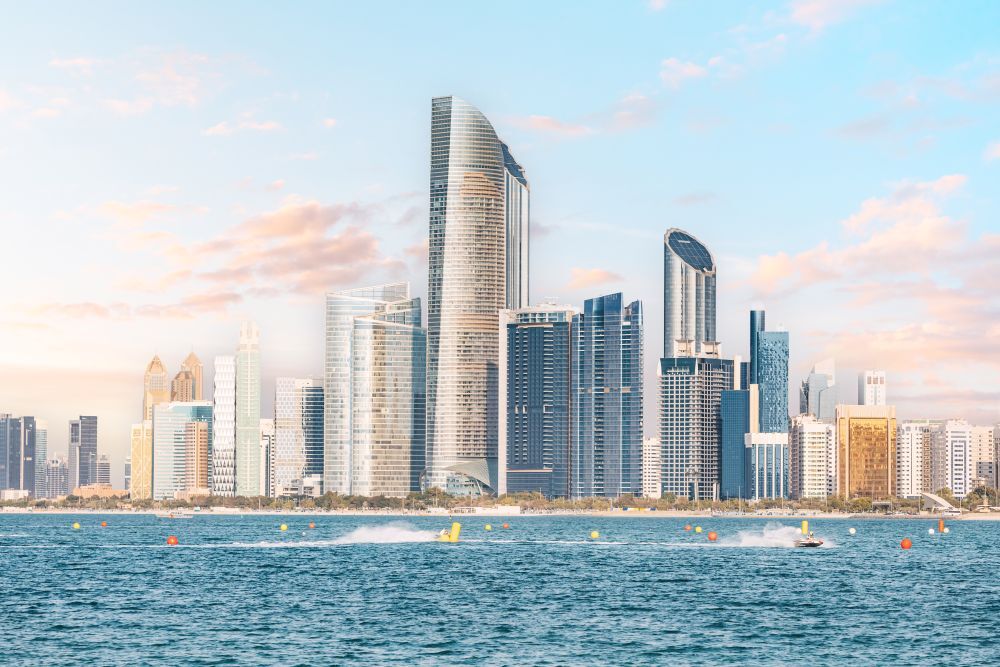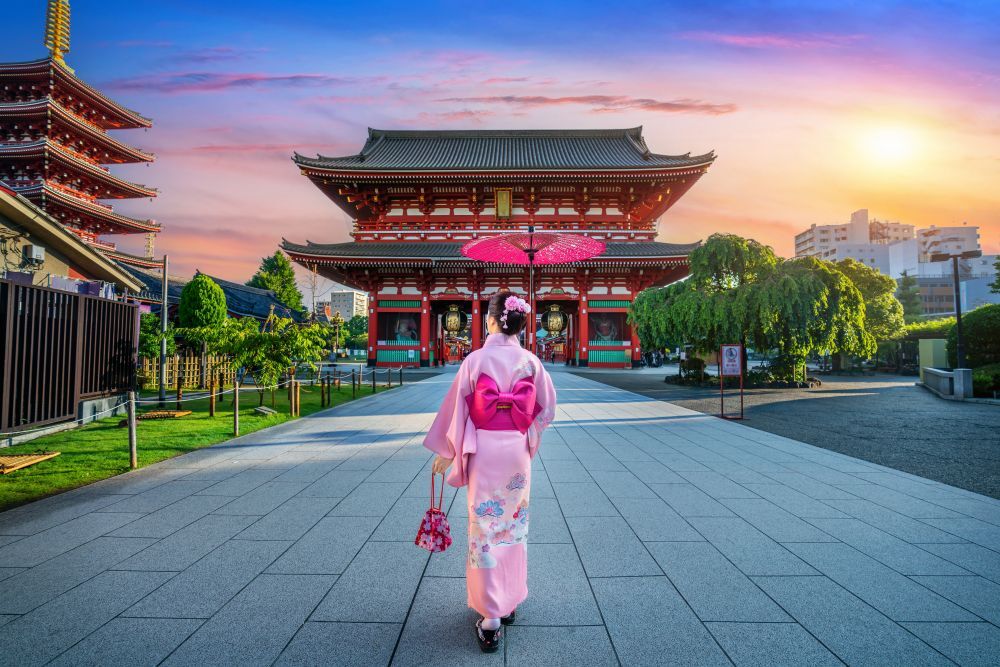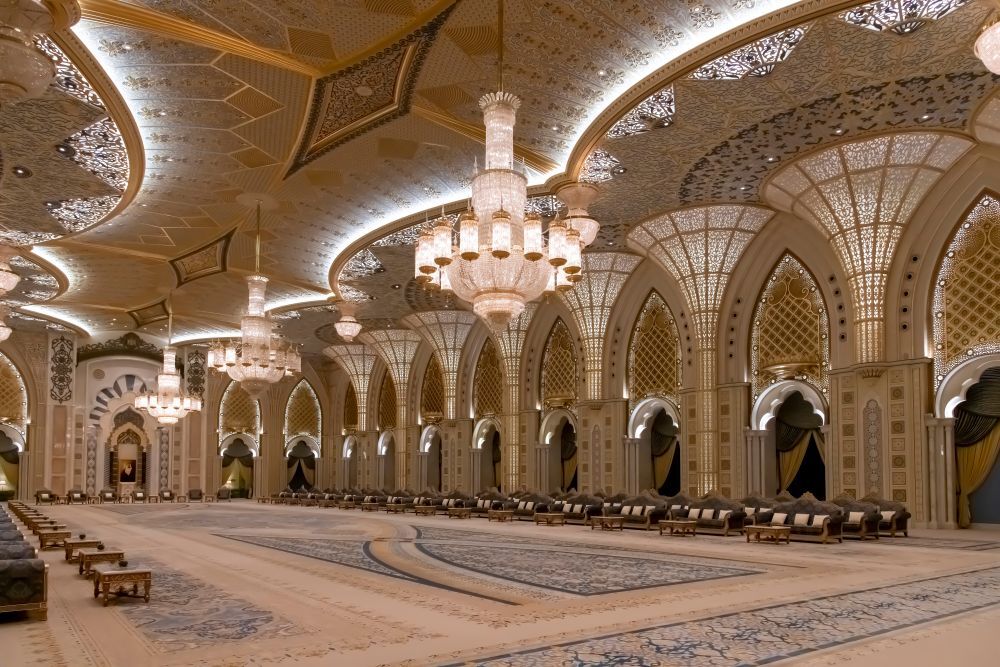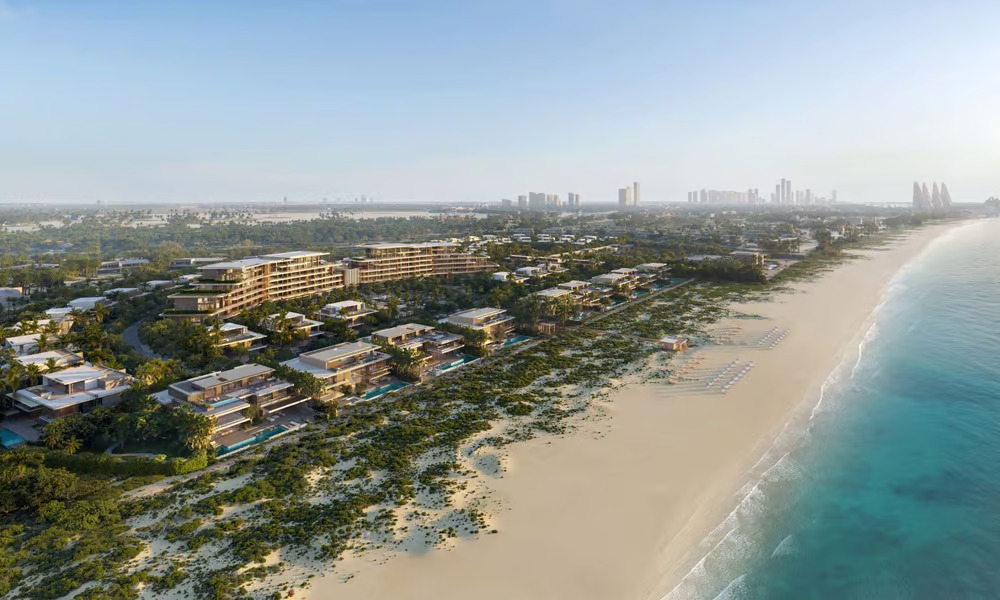Famous Buildings In Abu Dhabi
Abu Dhabi wasn’t always a place for architectural statements. Until the 1970s oil boom, the settlement was modest — fishing boats, trading dhows, and simple structures built for extreme heat.
Today, the city has assembled one of the Middle East’s most thoughtful collections of contemporary architecture. These aren’t just tall towers (though it has those too). The standout buildings make the most of their surroundings — capturing light, creating shade, reflecting water.
The next few years will be very significant. Already home to the Louvre Abu Dhabi, Saadiyat Island is now seeing long-awaited progress on the Guggenheim and Zayed National Museum — each responding in its own way to the island’s distinctive setting as they take shape in 2025.

Sacred Geometry
No building embodies Abu Dhabi’s architectural identity more than Sheikh Zayed Grand Mosque. Completed in 2007 after a decade of construction, it represents the UAE’s largest mosque and one of its most profound cultural statements.
The mosque’s statistics alone command attention — 82 domes, space for 41,000 worshippers, 1,096 exterior columns, and the world’s largest hand-knotted carpet. Yet numbers don’t quite capture what makes this structure extraordinary.
What distinguishes the mosque is how it complements Islamic architecture. Its design draws from Moroccan, Ottoman, Fatimid, and Mamluk influences, and the result feels unified rather than fragmented. The prayer hall’s 96 marble-clad columns, inlaid with mother-of-pearl, support domes whose internal geometries create a mesmerising play of light and shadow.
When viewed at dusk, with reflective pools doubling every column and dome in perfect symmetry, the mosque becomes almost metaphysical. This liminal quality captures something essential about Abu Dhabi itself — a city that honours its past while constantly reinventing its future.
The Impossible Circle
Sheikh Zayed Grand Mosque represents Abu Dhabi’s spiritual aspirations, but the Aldar Headquarters convey its technological ambition. Completed in 2010 by MZ Architects, this 110-metre-tall disc is the Middle East’s first circular building, along the Al Raha coastline.
The building’s striking form wasn’t chosen just for visual impact. The circle carries deep symbolic value in both Islamic geometry and universal mathematics. What appears at first glance as a simple shape reveals remarkable complexity upon closer look.
Creating a perfect circle at this scale required diagrid technology — a diagonal grid of steel that eliminates the need for internal columns. The result is interior spaces with endless views and a flexible layout. Despite having 23 floors, the headquarters has a floor area equivalent to a 40-storey tower.
Perhaps most impressive is how the building responds to its environment. Its glass façades are oriented to capture both sunrise and sunset, while the curved exterior functions as a natural wind deflector, reducing the impact of desert storms. The structure achieved LEED Silver certification through its use of recyclable materials and intelligent climate control systems.
At night, Aldar Headquarters takes on an almost otherworldly quality — a building that seems simultaneously impossible and inevitable, much like Abu Dhabi’s rapid transformation itself.
Rain of Light
Few buildings have stirred as much anticipation as Jean Nouvel’s Louvre Abu Dhabi. After years of delays and speculation, its 2017 opening marked a watershed moment — the first outpost of the famed French museum beyond Paris, and a bold statement of the emirate’s cultural ambitions.
The museum’s defining feature — a 180-metre wide, seemingly floating dome appears deceptively simple from a distance. Only with a closer look does its intricacy unfold, eight layers of interlocking geometric patterns creating 7,850 ‘stars’ of varying sizes. As sunlight filters through these apertures, it creates what Nouvel calls “a rain of light”, transforming the museum’s interior spaces throughout the day.
While the dome creates aesthetic effects, it also has functional purposes. The layered perforations reduce solar gain, maintaining natural light, creating a microclimate beneath that’s several degrees cooler than surrounding areas. The structure’s weight — an astonishing 7,500 tonnes, heavier than the Eiffel Tower — appears to rise above a collection of 55 white cubic buildings arranged like a traditional Arab medina.
The City’s Vertical Statement
The Etihad Towers show that when Abu Dhabi builds tall, it does so with intent. Completed in 2011, this cluster of five towers has become the signature of the Corniche waterfront.
Instead of identical heights, the towers rise in sequence, from 54 to 74 floors. The glass shifts too, its blue tint deepening toward the top, matching the Gulf waters.
Inside, it’s practically a small city: offices, flats, hotel rooms, designer boutiques, and destination dining. Tourists head straight for the Observation Deck at 300 (named for its height in metres), where the view showcases Abu Dhabi’s careful planning.
The towers are at their best after dark, making them a fixture of Abu Dhabi’s evening waterfront. Their screen time in “Fast & Furious 7” sealed their pop culture status, even if the film’s car-jumping-between-building stunt stretched architectural credibility.
The Presidential Palace
Qasr Al Watan opened to visitors in 2019, but most locals will tell you it takes at least two trips to properly see it. Rather than relying on spectacle, this working presidential palace reflects a deep understanding of Arabic design and symbolism. The craftsmen who created its intricate mosaics and domed ceilings clearly understood what they were honouring.
Domes and arches in white granite and limestone suggest tradition without showiness. It’s what happens inside that leaves visitors speechless. A 60-metre dome stretches overhead while walls display thousands of geometric patterns — no two exactly alike, all following precise mathematical rules.
Light changes everything in this building. Enormous chandeliers scatter patterns across the marble. The windows aren’t randomly placed — they capture sunlight at precise moments throughout the day. After sunset, the exterior becomes a light show — a regular attraction, typically scheduled in the early evening, that tells the story of the UAE’s past, present, and future.
Most government headquarters keep the public at arm’s length. But Qasr Al Watan splits its time between official business and cultural exploration. It’s a surprising twist for a presidential palace — and somehow, perfectly Abu Dhabi.
The Sustainable Vision
Masdar City began with grand promises. When Foster + Partners unveiled their plans in 2006 for a zero-carbon, zero-waste city in the desert, many called it visionary. Others called it impossible. Yet what stands today remains fascinating.
The completed sections draw cleverly from regional building wisdom. Streets run narrow and buildings cluster close, creating natural shade and channelling what breeze exists. Updated mashrabiya screens filter brutal sunlight. The temperature drops noticeably as you enter the development.
The Masdar Institute remains the project’s centrepiece, its warm terracotta walls surrounding a shaded courtyard. A prominent windcatcher tower pulls hot air upward – the same technology that cooled Gulf homes for centuries, now scaled up with modern engineering.
Though the full vision may never materialise exactly as planned, Masdar has proven surprisingly influential. As Abu Dhabi faces increasingly extreme temperatures, these old-meets-new cooling strategies have found their way into mainstream projects across the emirate.
Capital Gate
If architectural ambition can be measured in degrees, then Capital Gate’s 18-degree westward incline places it among Abu Dhabi’s most audacious structures. Certified by Guinness World Records as the “world’s furthest leaning man-made tower,” this 35-storey building appears to defy gravity.
Completed in 2011, the tower looks almost impossibly precarious. The engineering behind it is clever— the core was built slanting in the opposite direction, then gradually straightened as each floor added weight. The result appears to defy physics while actually working with it.
A diamond-patterned steel exoskeleton wraps the exterior, handling the complex stresses that come with an 18-degree tilt. This isn’t just structural necessity –the pattern creates a distinctive façade that changes as you move around it.
While other cities in the region compete for straight-up height records, Abu Dhabi chose to lean into something more intriguing. Capital Gate represents the city’s architectural personality perfectly — technically ambitious, visually distinctive, and just a bit unorthodox.
The Future
Abu Dhabi already has impressive buildings across its skyline, but what’s taking shape on Saadiyat Island is something else entirely. Construction cranes signal the city’s biggest architectural gamble yet — a cultural district expected to open in phases, with key institutions slated for completion by late 2025. When finished, the area will pack more star-architect-designed museums into one location than almost anywhere else on earth.
The Guggenheim Abu Dhabi has been on and off for years, but Frank Gehry’s design is now visibly rising from the sand. It’s expected to be the largest Guggenheim in the world — no small feat considering the number of museums across the globe. Rather than mimicking Bilbao’s shiny waves, Gehry has designed something that makes sense in the desert. The galleries will eventually cover 42,000 square metres, focused primarily on contemporary art from the surrounding regions.
Just next door, Foster + Partners’ Zayed National Museum makes its own statement with five towering steel ‘feathers’ that slice into the sky. These aren’t just for show. They’re cleverly designed to pull hot air upward and cool the building naturally. The design reflects falconry, a passion of the UAE’s founding father. In the evening, these illuminated spires will be visible for kilometres around.
The Natural History Museum rounds out the trio with a completely different approach. Instead of sharp angles and metal, Mecanoo’s design flows like water-carved stone. Its centrepiece will be a massive dinosaur fossil nicknamed ‘Stan’, displayed beneath an atrium.
Though visually distinct, each project aims to create something that wouldn’t make sense anywhere else.
Reflections on a City’s Architectural Identity
Architecture tells you what a city values. In Abu Dhabi's case, that's neither blind futurism nor stubborn nostalgia, but something more nuanced.
The city has developed its own architectural language over the past two decades — one that respects tradition without being captive to it. The best buildings here understand where they stand, both literally and culturally.
As the next phase of development takes shape, Abu Dhabi stands between its architectural legacy and the opportunities ahead. The foundations are in place and it remains to be seen how they’ll shape into existence what comes next in the capital.



